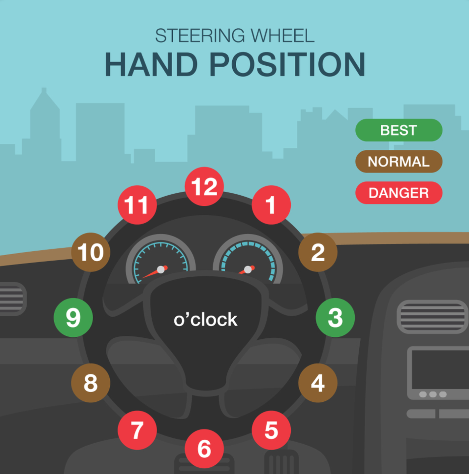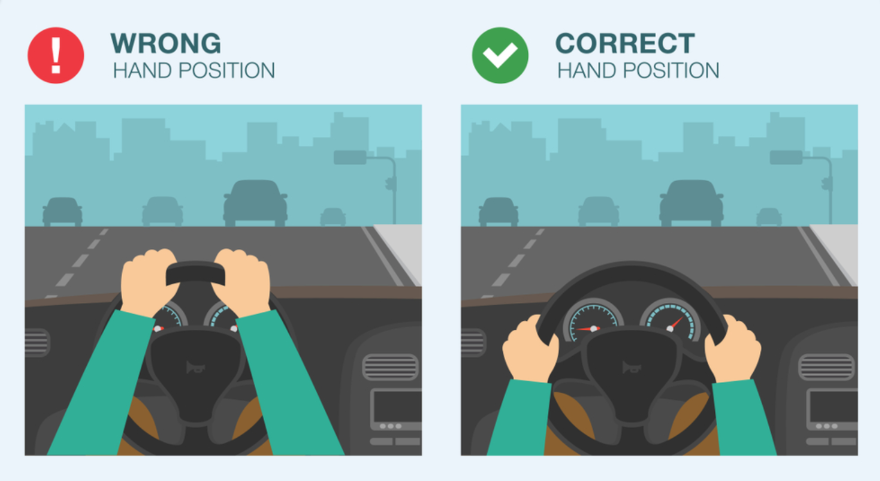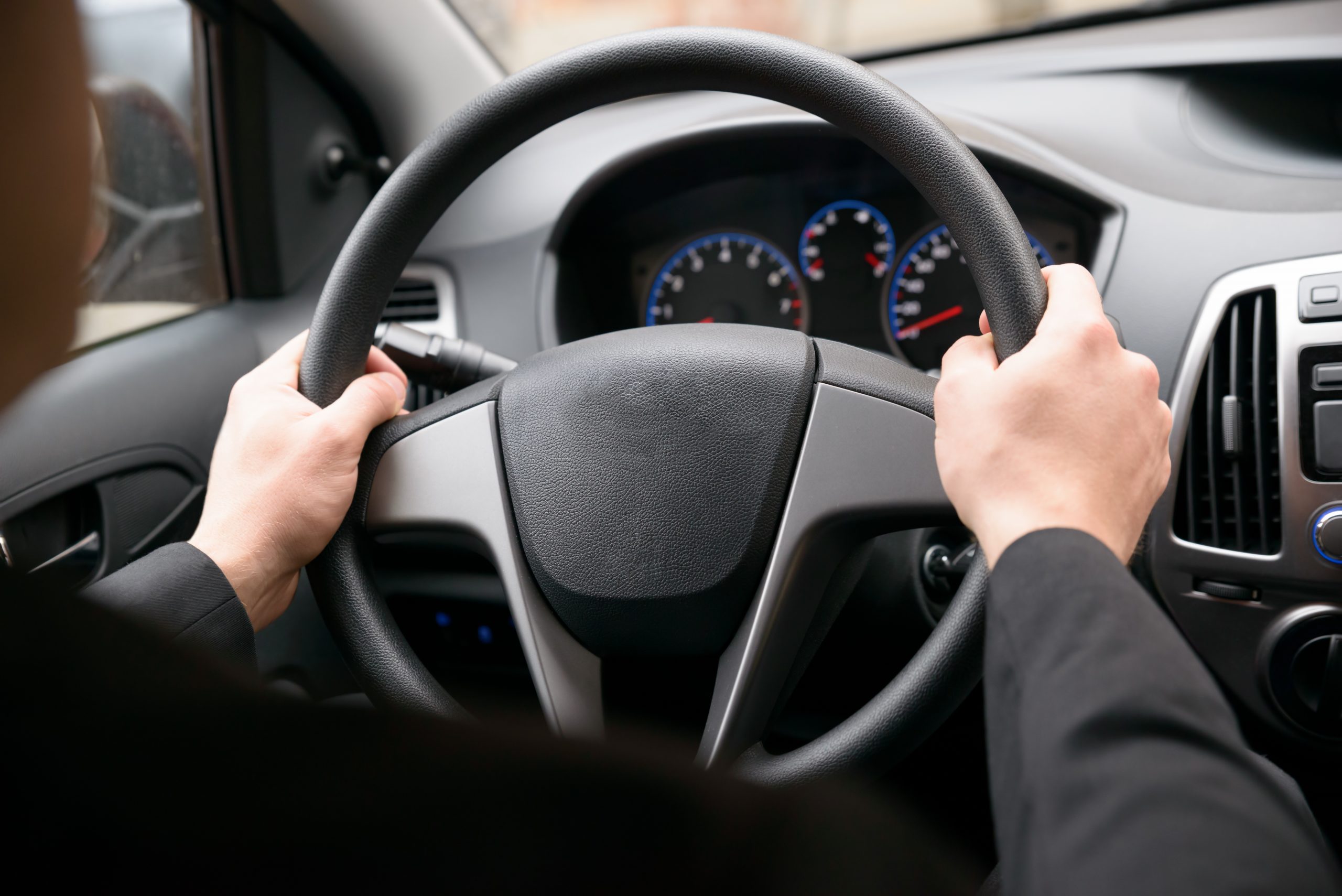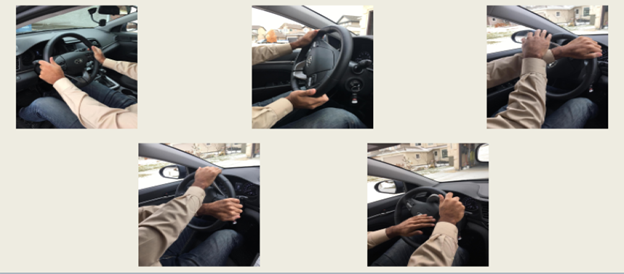Steering Wheels

Steering Wheel (Proper Hand Position, Turning Methods)

Vehicles can be useful and fun to drive, but only if they are managed well. Drivers direct vehicles in the direction they want to go with the steering wheel. Using the steering wheel properly is important for keeping any size of vehicle under control. From using the best hand position to learning the right turning methods, drivers need to learn how to use the steering wheel properly.
Driving is a complicated task with the lane changing, stopping, starting, and watching for other road users that people need to do. It might seem like too much to remember proper use of the steering wheel. Yet holding and moving the steering wheel properly can help people maintain better control of the vehicle.
Imagine steering wheel as a clock and place your hands in the nine and three position at all times while driving. Never drive with only one hand, your fingertips, or, even worse, with your knees. Do not eat or drink while driving because that will force you to take your hands off the wheel.

Proper Position to Hold a Steering Wheel (9 and 3 vs 10 and 2)
Good driving techniques would seem to be related to people’s skills and their ability to follow directions. Sometimes, however, a problem can be related to their age and the rules in place when they first learned to drive, as is the case with how drivers hold the steering wheel. Anyone who learned to drive 3 or more decades ago might need to change their techniques to operate a vehicle safely.
The 10 and 2 Position
People who took driving lessons before about 1990 likely remembers the ten and two position. The idea was to picture the steering wheel as a clock and to place the left hand at what would be the ten o’clock position and the right hand at the two o’clock position. This position gave drivers good control over the steering process, especially on turning corners, and experts recommended it to student drivers as the best hand position on the road.

The recommendation for the ten and two hand positions came at a time before airbags were common. Now, the best advice is to place the hands at the 9 o’clock and 3 o’clock position with the thumbs resting on the rim of the wheel rather than being curled around it. Otherwise, the airbag could cause serious injuries in the event of an accident. When it deploys, it could send the hands flying back into the face, possibly breaking the fingers or injuring the head.
Although airbags are designed to save lives, they come with their own dangers, as Darcy Wintonyk and Lynda Steele explain in a 2012 CTV article. Airbags deploy at 320 kilometres per hour and fully inflate in a fraction of a second. This amount of time is not enough for people to get their hands and arms out of danger. The force of the airbag can propel the hands back towards the face and head, possibly causing much worse injuries than would otherwise result.
Injuries and Accidents
The idea behind the 9 and 3 hand positions is not to attempt to prevent all injuries, as many other factors affect the likelihood of sustaining bruises or broken bones. For example, the Canadian Centre for Occupational Health and Safety recommends leaving approximately twenty-five to thirty centimetres between the driver’s chest and the steering wheel for maximum safety in case of an accident. If a driver sits closer than that, it could lead to injuries in an accident.
Airbags are designed to protect the head by cushioning it from the impact of a collision. Anything that gets in the way, such as an arm, can make the airbag ineffective. When drivers use the 10 and 2 position, their arms can block the airbag. The 9 and 3 position keeps the arms far enough from the steering wheel to protect them in case of an accident.
Transport Canada’s website notes that traffic accidents in 2017 caused 112,479 personal injuries and 9960 serious injuries in which the victim was admitted to the hospital for treatment or observation. In both of these cases, the numbers were lower than they had been in previous years. Still, good driving techniques can reduce injury statistics even further. By keeping their arms out of the way of the airbag, drivers can help prevent injuries from a deploying airbag. Although a broken arm is less serious than many other injuries, drivers should still be aware of what could happen if their arms are in the way of a deploying airbag.
Muscle Strain
A further advantage of the 9 and 3 position is reduced strain on the muscles. One of the dangers of driving for long periods of time is muscle fatigue from holding the arms in an unnatural position for long periods of time. At the 10 and 2 position, the arms can become tired very quickly from being raised to that extent, and drivers may be tempted to rest their muscles by planning their hands at the bottom of the wheel, where they have little control over steering around corners.

Muscle strain can still happen at the 9 and 3 position, but it is less likely since the arms are closer to the resting position at that point. A further benefit could also be a reduction in the effects of vibrations on the arms and hands. These types of injuries apply mainly to the use of tools such as jackhammers and chainsaws, as the Ontario.ca website explains. Still, long hours of driving can have similar effects, causing the fingers to become numb and the arms to ache. The 9 and 3 position allows drivers to hold onto the steering wheel with a lighter grip than at the 10 and 2 position, thus reducing the effect of vibrations on their hands and arms.
According to a 2013 Business Insider article by Alex Davies, the recommendation for the 10 and 2 hand position came at a time before power steering, when drivers needed additional force to be able to turn the wheel. Holding the steering wheel near the top allowed them space to pull down before switching hands to complete the turn. However, power steering has largely made that benefit obsolete, while the advent of airbags has made those guidelines dangerous. When the hands are further down on the wheel, they are likely to be knocked out of the way instead of hitting the face in an accident.
Recommendations
Although the Ontario Ministry of Transportation handbook does not discuss the reasons for its choice, the recommendation on the website also is to use the 9 and 3 positions. There, drivers should be able to do most of their steering and other basic driving operations without lifting their hands off the wheel, with the exception of changing gears in a manual transmission vehicle.
Habits can be hard to break, and people who learned how to drive in the 10 and 2 era might find it difficult to change. However, all drivers, whether they have years of experience or are still learning, should learn to use the 9 and 3 hand position on the steering wheel for improved safety and comfort.
Adjustments and Hand Positions
The first aspect to consider when a driver enters a vehicle is the height and angle of the steering wheel. Unless only one person drives a vehicle, the next driver is likely to need to adjust the wheel to the right placement for comfort and control. Levers under the steering column allow drivers to move the steering wheel up or down or to adjust the angle to fit their height, weight, and arm length.
The next point is hand placement. Recommendations for hand positions are based on the idea of imagining the steering wheel as a large clock with numbers around the edges. Traditionally, driving instructors recommended using the 10:00 position for the left hand and the 2:00 position for the right hand.
However, as the Ontario Ministry of Transportation’s online handbook states, the 9:00 and 3:00 hand positions are now considered best for controlling a vehicle. For most steering and lane changes, drivers can maintain these hand positions, even as they move the left hand slightly to turn the signal lights on or off.
Curves and Smooth Steering
Most trips in a vehicle involve more than just driving straight ahead. Operating a vehicle also involves managing curves and turns while still maintaining control of the steering wheel. For many curves, drivers can still maintain the same hand position on the wheel, possibly making a few small adjustments if the curve is long or sharp. However, making a turn involves a different type of steering wheel use.
Smooth steering is important for safe and predictable driving. Most road users expect drivers to stay in their lanes or to signal their intentions to turn. If a driver weaves between lanes or veers towards one side or the other, it could confuse other drivers and cause them to crash.
Sometimes, drivers steer erratically because they are not paying attention to the road, and sometimes they have trouble becoming accustomed to the intricacies of steering. Occasionally, they may be forced to jerk the wheel to the side to avoid an unexpected obstruction, such as a large animal or another vehicle getting in their way. In general, however, smooth steering is the best option.
Steering Methods
There are two methods of steering which can be used when turning.
- Push and Pull method
- Hand over Hand method
Performing these methods properly can provide smooth and safe steering control.
Push and Pull Method
You may also hear this method described as “shuffle steering” or ‘hand to hand steering”.
In push-pull steering, the driver feeds the steering wheel through their hands, with both arms remaining on their respective sides of the wheel.
When using this technique, your hands will move closer and further apart but will never cross over. If the air bag deploys, the risk of injury will be minimal as your hands will not be in the way.

Hand Over Hand Method
For a sharp turn, turn the steering wheel with one hand and cross the other hand over it.
Grip the wheel on the other side and continue turning. This is called “hand over hand steering.”
When you have completed the turn, relax your grip on the steering wheel and let it slip or gently feed it through your hands to return to the straight-ahead position. Do not turn the steering wheel with one finger or the flat palm of your hand. Gradually increase speed as you complete the turn.

Keeping both hands on the steering wheel is important, but it is not always possible. In manual transmission vehicles, for example, the driver needs to take a hand off the steering wheel to change gears. When it is necessary to stop frequently or to vary the vehicle’s speed, such as in heavy traffic, this may necessitate long periods of one-handed steering. Using the horn in the middle of the wheel, adjusting the heat, or turning on the window defrosters also require drivers to take a hand off the steering wheel. However, it is important to try to keep both hands on the wheel whenever possible.
Power Steering and New Technology
An issue that applies mainly to older cars is a lack of power steering. According to Jil McIntosh on the Driving.ca website, steering used to require substantial arm strength until the advent of power steering. This term refers to a system that uses hydraulics, electric power, or a combination of both to help the steering wheel move easily. The first manufacturer to use this system was Chrysler in 1951, and now all new vehicles come with this feature. Still, some vehicles without power steering, especially large trucks or older cars, may be on the roads.
As technology has improved, researchers have found new ways of helping drivers with steering. Lane-keeping assist features warn drivers if they stray too far towards the next lane or the edge of the road. As technology continues to improve, steering could become even easier.
Technology can help, but drivers also need to develop the skills to steer well and consistently in any weather and traffic conditions. Frequent practice and consciously reviewing the techniques on the road can help even the most experienced driver avoid any problems that often come from inconsistent or sloppy steering. If you develop strong steering skills, you will have an ability that can help you in any driving situation.
